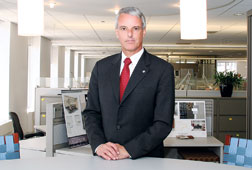 |
| Buying Spaulding & Slye gives JLL base in Boston and residential work. (Rendering courtesy of Spaulding & Slye/Jones Lang LaSalle)
|
Even with a balance sheet that screams success, a share value that hit an all-time high in April, and rosy predictions of a bright future, Colin Dyer, president and CEO of Chicago-based global real estate and project management megafirm Jones Lang LaSalle Inc. (JLL), still needs reassurance.
There is, of course, JLL’s first appearance in 2006 on Forbes magazine’s prestigious Platinum 400 list for high-performing public firms, and its selection by major real estate client Procter & Gamble as External Business Partner of the Year for “sustained and significant value creation.” But even with those corp- orate ego boosts, Dyer probably can’t wait for results of the firm’s annual employee survey to see how motivated and engaged his 22,000-person worldwide work force is. “Our aim is to constantly reinforce our reputation,” he says. “There is no room for complacency.”
JLL’s growth in the U.S. and abroad is hardly complacency. A lot has changed since the real estate firm’s British parent was founded as an auction house in 1783. It took the eventual U.K. global developer, Jones Lang Wooten, another two centuries to link with its American partner, a onetime Texas commercial real estate firm that became a Chicago fixture as LaSalle Partners. But the firms’ 1999 merger—and the boom in real estate as a valuable asset and hot commmodity—fueled a powerhouse that operates in 430 cities across 50 countries and reported $1.4 billion in revenue in 2005 (see chart below).
| 2005 | 2003 | 2001 | |
| TOTAL | |||
| Revenue ($ mil.) | 1,390.6 | 941.9 | 896.9 |
| Net income ($ mil.) | 103.7 | 36.1 | (15.4) |
| # of professional and onsite staff | 22,000 | 17,300 | 16,700 |
| Property under management (mil. sq ft) | 903 | 725 | 725 |
| AMERICAS UNIT | |||
| Revenue ($ mil.) | 435.3 | 313.5 | 327.9 |
| # of professional and onsite staff | 7,200 | 5,900 | 5,300 |
| Property under management (mil. sq ft) | 405 | 300 | 320 |
| EUROPE UNIT | |||
| Revenue ($ mil.) | 492.8 | 351.1 | 344.8 |
| ASIA UNIT | |||
| Revenue ($ mil.) | 272.9 | 172.7 | 129.6 |
JLL’s real estate scope is huge and varied, from research and consulting to client-based property management and investment services. The firm’s investment arm, LaSalle Investment Management, now boasts more than $30 billion worth in managed real estate “assets,” 25% more than in 2004.
JLL now is taking its expertise onto the jobsite, pushing more prominently into construction project management, where it hires and partners with industry firms—and competes against them. The firm this year is in the Top 10 of CM-for-fee firms, up from 15th place on ENR’s 2005 listing (see p. 41). It reports $181 million in total CM-for-fee and program management revenue for 2005, up from $116 million a year before.
While the numbers don’t bring JLL close to the industry’s top CM and program management players, its real estate tentacles position the firm for lots more project work. Potential clients are impressed with the firm’s professionalism and they love soup-to-nuts providers.
Flush with cash, JLL’s acquisitions are providing new geographic bases, market niches and additional expertise. The firm now claims to have 1,000 project management “professionals” on staff around the world. Its latest annual report says the Project & Development Services team in India has increased “four-fold” in the last two years. At least 700 PDS staffers are in the U.S. alone.
 |
| Peter Belisle |
“CM-PM is a core competency for us,” says Peter Belisle, Los Angeles-based PDS president for JLL’s Americas group. The veteran of two California contractors, Hathaway Dinwiddie Construction, San Francisco, and Snyder-Langston, Irvine, says PDS made up just 11% of JLL revenue last year, but the best is yet to come. “It is a high-growth business limited only by finding the right good people,” says Belisle, a civil-structural engineer who joined JLL five years ago and gained his current job in January.
JLL’s PDS crew can take heart that they will play a key role in at least two of the “G5,” the firm’s five growth strategies outlined by CEO Dyer in 2005. One is being “the best in every local market where we compete.” The other is becoming a “global leader in outsourced corporate real estate services.” Dyer sees the latter related to corporate America’s continued push to shed “peripheral things,” he says. “Corporations are looking at core skills. What adds value?”
 |
|
Engineer to Mogul. CEO Dyer once drove a forklift. Now he’s lifting firm’s fortunes with more real estate and project management services. (Photo by Tudor Hampton for ENR) |
Dyer says that, in managing real estate, JLL has “economies of scale and a huge knowledge base of best practice.”
PDS professionals might also be heartened by their leader himself. Dyer, 53, is U.K.-born and initially educated as a mechanical engineer. He operated a forklift as a teenager and worked as an apprentice engineer “fixing pipes” in BP Chemicals plants in Britain and France, he says. He went on to a variety of business, management and entrepreneur roles in overseas banking, textiles and internet retail. Dyer joined JLL in his current role in 2004.
Collegiality
While real estate is a new specialty for Dyer, his knowledge of corporate and financial worlds, particularly overseas, could be more critical to his vision. “The strategies Colin has in place are fantastic and the people here are the best in the industry,” says Mike Sivewright, Atlanta-based manager of PDS. Dyer sees “the quality of people we hire” as a JLL differentiator, as is the “high collegiality between our teams,” he adds. JLL directors seemed to appreciate Dyer’s impact, adding a $2.25-million cash-stock bonus to his $750,000 salary for 2005, according to the firm’s proxy statement.
Others praise some key skills inherent in the company. “They start from a history of real estate and development,” says Kathi Littman, a construction management consultant and former ENR Award of Excellence Winner who worked at JLL in the late 1990s. “They are strongly trained in risk analysis.”
Despite JLL’s focus on strong internal development, some contractor veterans of JLL projects use terms such as “oversold and overextended” to describe the fast-growing firm’s project management capabilities. “There are some unqualified people running jobs,” says one contractor executive who declines to be identified.
JLL already is seeing financial gains in its U.S.-based PDS work, in part fueling a 53% hike in first quarter 2006 revenue for the Americas group. The increase brings its revenue share closer to that of Europe, the traditional leader.
Strategic acquisitions in the U.S. have helped a lot. Most recent is JLL’s $150-million purchase of Boston-based developer-construction manager Spaulding & Slye, completed in January. The deal gives JLL its first base in the hot Boston real estate market and adds to its presence in Washington, D.C., with more than 500 new employees and new skills in CM, PM, development management and residential markets for the first time, says S&S principal Kyle Warwick. “All of a sudden, we became their local market strategy,” he says.
S&S is the leasing agent, property manager and CM for NorthPoint, a planned $2-billion mixed-use “transit village” in Cambridge, Mass. The first phase is set for completion next year. “We’re still bullish even with interest rates going up,” says Warwick. “They won’t impact us until they get above 8%.”
JLL already had gained a foothold in the tough New York-area market by buying Quartararo & Associates, a Manhattan-based project/development management firm in 2004. It had only 55 employees and annual revenue of $12 million at the time, but strong links to such high-profile Big Apple clients as Time Warner.
“We were a little boutique company when corporate clients started changing procurement processes and not using local firms,” says firm founder Ray Quartararo, now a JLL managing director of PDS. “I needed more horsepower.” He says the link helped secure a big Madison Square Garden renovation contract, now delayed by politics over the redevelopment of the city’s Farley Post Office.
Quartararo says he now has 115 “project professionals” in New York, including an office manager who was his previous client contact at Time Warner. JLL is executing a $1-billion reconfiguration of the suburban New Jersey campus of drugmaker Novartis. The firm also serves as an “ad hoc” advisor to the Port Authority of New York and New Jersey at Ground Zero, “responsible for project specific issues and overall coordination on site,” says Quartararo. “How will the multiple buildings planned there interact?”
JLL’s acquisition spree has invigorated the PDS unit, which already has a daunting mission in its four key areas of real estate activity. In addition to individual projects, the firm offers “multi-site program management” when clients expand or go through rebranding. Not all involve construction. “We did 6,500 sites for Cingular in 12 months,” says Sivewright. JLL also is managing kitchen modifications for Starbucks stores across the U.S. and is helping Bank of America build 100 branches a year, he adds.
One Stop
Outsourced property management is the other big arena. In March, Sun Microsystems chose JLL to handle real estate services for its worldwide offices, labs and plants—comprising 17 million sq ft in 44 countries. The value of the five-year contract was not disclosed.
Cincinnati-based Procter & Gamble has outsourced the function to JLL since 2003, part of the manufacturer’s “journey” to shed non-core functions in 86 countries...
�
Post a comment to this article
Report Abusive Comment